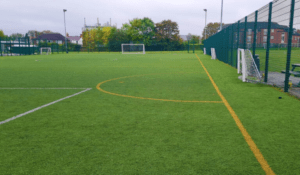Youth sports play a vital role in the physical and emotional development of young individuals. However, in recent years, concerns have been raised regarding the long-term effects of playing on artificial turf, commonly known as astroturf.

While it offers a convenient and durable alternative to natural grass, astroturf presents a range of potential risks that are often overlooked. This in-depth news article aims to delve into the effects of astroturf on youth players, shedding light on the hidden dangers that may impact their health and well-being.
Health risks
- Increased Risk of Injuries: Numerous studies have shown that playing on astroturf increases the risk of certain injuries compared to natural grass. The lack of cushioning and increased friction on astroturf can lead to higher rates of ankle sprains, knee injuries, and skin abrasions. The unforgiving surface amplifies the impact on joints and muscles, potentially resulting in more severe injuries.
- Heat-Related Concerns: Astroturf tends to absorb and retain heat, making it significantly hotter than natural grass. This can lead to an increased risk of heat-related illnesses, such as heat exhaustion and heatstroke, particularly in hot climates or during summer months. The excessive heat can also cause dehydration and fatigue, impacting performance and increasing the chances of injury.
There are some long-term health effects when it comes to astroturf pitches.
- Joint and Musculoskeletal Problems: The repetitive nature of sports activities on astroturf can place excessive stress on joints and muscles over time. This may lead to chronic issues such as joint pain, tendinitis, and even premature arthritis. The unforgiving surface can also hinder proper shock absorption, potentially contributing to long-term joint damage.
- Respiratory Concerns: Many astroturf fields are composed of rubber infill, typically made from recycled tires. The release of volatile organic compounds (VOCs) from rubber infill can pose respiratory risks, especially for players who frequently inhale the small particles present in the air. Studies have indicated potential links between exposure to these substances and respiratory issues, including asthma and other breathing difficulties.
Here are some psychological and developmental impacts of astroturf pitch
- Psychological Factors: The playing environment and surface can affect the psychological well-being of young athletes. The increased risk of injuries and fear of falls on astroturf may impact players’ confidence and mindset, affecting their overall performance and enjoyment of the game.
- Skill Development and Style of Play: Astroturf’s unique playing characteristics, such as increased ball speed and bounce, can influence the development of technical skills. Players may become heavily reliant on these specific conditions, potentially hindering their adaptability when transitioning to natural grass or different playing surfaces.
Regulatory measures and solutions
Recognizing the potential risks associated with astroturf, regulatory bodies and organizations are taking steps to mitigate these hazards. Some measures include:
- Improved Field Design: Organizations are advocating for better design and construction of astroturf fields, focusing on features such as increased shock absorption, proper drainage systems, and improvements in surface temperature control.
- Adoption of Alternative Turf Materials: Research and development are underway to explore alternative turf materials that provide a safer playing surface, reducing the potential risks associated with traditional astroturf.
Conclusion
In conclusion while astroturf offers convenience and durability for youth sports, it is crucial to recognize the hidden dangers it poses to young athletes. The increased risk of injuries, potential long-term health effects, and psychological impacts should not be overlooked. As the sports community strives to prioritize player safety and well-being, efforts should be made to spread awareness, implement stricter regulations, and invest in safer alternatives to mitigate the risks associated with astroturf, ensuring a healthier and safer playing environment for youth players.
>>>the writer is a talented and passionate individual who has excelled in various fields throughout his life. He has developed a deep appreciation for his culture and heritage, which has heavily influenced his personal and professional endeavors. He is currently pursuing a degree course in Journalism at the University of Media Arts and Communication (UniMAC-GIJ). He can be reached via [email protected]










